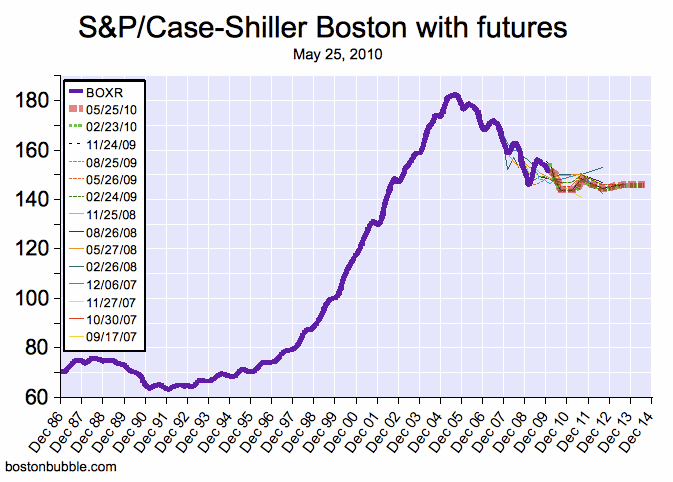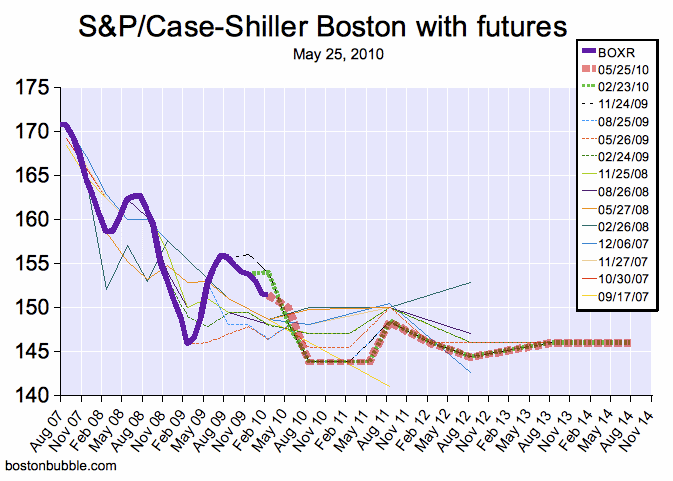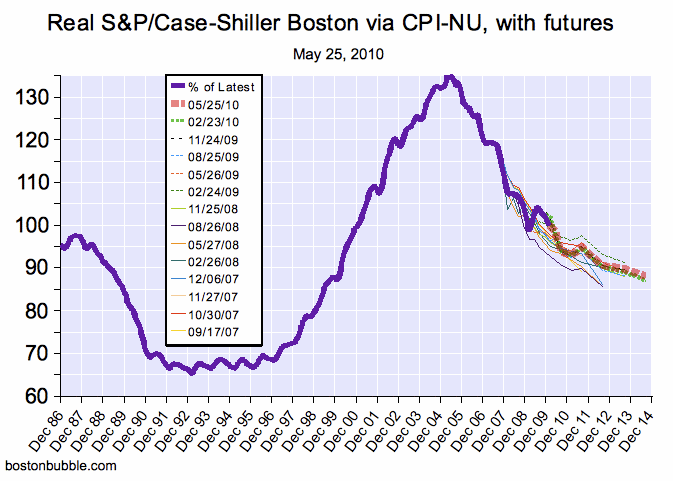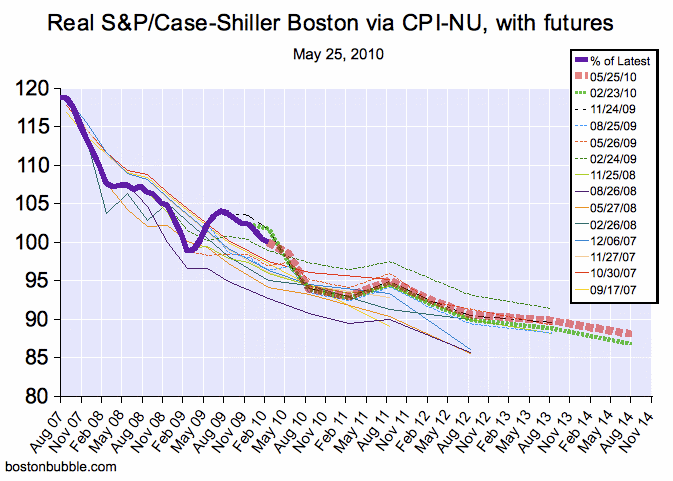 |
bostonbubble.com
Boston Bubble - Boston Real Estate Analysis
|
|
SPONSORED LINKS
Advertise on Boston Bubble
Buyer brokers and motivated
sellers, reach potential buyers.
www.bostonbubble.com
YOUR AD HERE
|
|
DISCLAIMER: The information provided on this website and in the
associated forums comes with ABSOLUTELY NO WARRANTY, expressed
or implied. You assume all risk for your own use of the information
provided as the accuracy of the information is in no way guaranteed.
As always, cross check information that you would deem useful against
multiple, reliable, independent resources. The opinions expressed
belong to the individual authors and not necessarily to other parties.
|
| View previous topic :: View next topic |
| Author |
Message |
admin
Site Admin
Joined: 14 Jul 2005
Posts: 1826
Location: Greater Boston
|
 Posted: Fri May 28, 2010 1:32 am GMT Post subject: S&P/Case-Shiller Boston Snapshot: May 25, 2010 Posted: Fri May 28, 2010 1:32 am GMT Post subject: S&P/Case-Shiller Boston Snapshot: May 25, 2010 |
 |
|
On Tuesday, May 25th, Standard & Poor's released the S&P/Case-Shiller housing price index data for March 2010. Boston area single family home prices rose 3.83% from one year earlier, in nominal terms, which was an increase of 1.22% when adjusted for inflation.
The May 2010 futures contracts for the index, which cover prices in the first quarter of 2010, were also settled on the same day. When the extended S&P/Case-Shiller futures were first introduced, Mike suggested that somebody archive the predictions of the futures contracts, and I proposed that a good time to do that would be each day that a futures contract is settled (i.e., quarterly). This post is an attempt to provide such a time capsule for the future.
Below are two graphs of the S&P/Case-Shiller Index for Boston from 1987 through the present (shown in solid purple), with the expected future values added using the values of the futures contracts on the indicated dates:


The market is pricing in the following with respect to nominal housing prices through 2014 Q3:
- An additional decline from the most recent month of 5.03% by 2010 Q3.
- A total decline from the peak of 21.18%.
- Essentially flat nominal prices from the bottom through 2014 Q3, which is as far as the futures go.
The market expectation implied by the closing values of the futures contracts on May 25th is that nominal prices have temporarily bounced off of the bottom, will return there over the coming months, and will then remain flat for as far into the future as contracts are available. Prices had previously arrived at the level predicted as the bottom by several of the past futures snapshots, but they did so earlier than predicted. Their bounce above previously predicted levels is quite possibly the result of the temporary home buyer tax credit.
Of course, flat nominal prices imply falling real prices when inflation is present, and it is. In past reports before November 25, 2008, the futures contracts were corrected for inflation using the adjusted 10-year TIPS-derived expected inflation published by The Federal Reserve Bank of Cleveland. Unfortunately, they discontinued publication of this series on October 31, 2008 citing an "extreme rush to liquidity" as making the estimates no longer accurate. Consequently, future inflation from then on has been estimated using the yield on 5 year Treasuries. There have been suggestions for improving this method of estimation. The suggestions are appreciated and will hopefully be reviewed and assimilated as time permits in the future. Time constraints led to the use of the yield on 5 year Treasuries again this month.
Here is the same housing data adjusted for inflation, expressed as a percentage of real prices from the most recent month:


The market is pricing in the following with respect to real housing prices through 2014 Q3:
- An additional decline from the most recent month of 11.85%
- A total decline from the peak of 34.91%.
Note that the volume on the futures contracts is currently very sparse, and so using them to predict future housing prices should be viewed as unreliable. However, bear in mind that other sources of predictions are most likely even less reliable, especially organizations like The NAR which have a disincentive for accuracy. The futures markets are probably the least biased predictor available, given that those trading the contracts have a direct financial incentive to be accurate (real money rides on the accuracy).
Also note that the contract values might not necessarily reflect the expected value of the index if there are unaccounted opportunity costs involved. This was discussed in some detail in the original thread when the extended futures debuted. It is my current understanding that both the buyer and seller would have the same opportunity costs (a performance bond and transaction costs), and these costs would therefore offset each other when viewing the value as predictive. This could be wrong, though. If you would like to discuss this point, please read the original thread first since there are some references there to support the assumption of symmetry.
The settlement data for the futures contracts on the 25th was:
- May '10 151.42
- Aug '10 150.00
- Nov '10 143.80
- Feb '11 143.80
- May '11 143.80
- Aug '11 143.80
- Nov '11 148.40
- May '12 146.00
- Nov '12 144.40
- Nov '13 146.00
- Nov '14 146.00
Previous snapshots are available for:
- February 23, 2010
- November 24, 2009
- August 25, 2009
- May 26, 2009
- February 24, 2009
- November 25, 2008
- August 26, 2008
- May 27, 2008
- February 26, 2008
- December 6, 2007
- November 27, 2007
- October 30, 2007
- September 17, 2007
Please do try this at home, in order to bring to light any errors. The data used for the above report was obtained from the following sources:
The text of this post and the associated graphs are Copyright 2010 by bostonbubble.com with all rights reserved, except as stated here. You may reproduce the graphs individually or the text of the entire post as a whole (including graphs) under the Creative Commons Attribution-No Derivative Works 3.0 Unported License. You may additionally scale the graphs to fit your work. Alternatively, if you remove the bostonbubble.com signature from the bottom left hand corner of the images within this post, those modified images (and only those modified images) can then be distributed under the Creative Commons Attribution 3.0 Unported License. In all cases, attribution should be made via a hyperlink to http://www.bostonbubble.com/forums/viewtopic.php?t=2817 or http://www.bostonbubble.com/ Quoting excerpts of the text is also allowed provided that the quotes would normally fall under fair use. To request other terms for reproduction, please post your request in the original thread at http://www.bostonbubble.com/forums/viewtopic.php?t=2817
The latest version of this report can be found at http://www.bostonbubble.com/latest.php?id=spcsi_bos_snapshot
- admin |
|
| Back to top |
|
 |
GenXer
Joined: 20 Feb 2009
Posts: 703
|
 Posted: Fri May 28, 2010 12:49 pm GMT Post subject: Posted: Fri May 28, 2010 12:49 pm GMT Post subject: |
 |
|
Just an observation.
When I take this data, compute a relative difference (i.e. first difference)and generate a CDF normalized by the standard deviation, I get 4.8 sigma as the highest 'jump' in prices (because to generate the CDF, the data is arranged by the order of magnitude of the jumps, so I don't know what date this jump corresponds to, but this is not really important). The probability of this, using the standard Normal distribution is 1-erf(4.8/sqrt92)) which is about 1.6*10^(-6). That is, this is a very large deviation for a MONTHLY price chart, if this was a bond, for example.
While this is not as volatile as the price of bonds, one has to consider that these are MONTHLY prices. If I get a MONTHLY bond price, the volatility will appear to decrease quite a lot compared to daily price. Of course, we can argue that it makes no sense to produce daily S&P Case Schiller index, and I agree, but this does not mean that prices can NOT be more volatile on daily/weekly basis than on a monthly basis. Given enough liquidity, these movements can probably be tracked. This is another reason why local price data can be misleading (and also why 'estimating' a price locally may be near impossible, as it can change quickly). We can argue that the real estate market is not very liquid, and prices can linger for a while, but this is probably changing, as everything is becomes computerized and one will soon be able to access prices online in 'real time' (zillow already has some sort of pricing algorithm). While these prices can show price trend movements, there is still a long way to go to get the prices set by the 'market', not by individual buyers and sellers (who may 'persist' with prices that are too high despite the market saying that the prices are actually lower). This may actually lead to a big imbalance, which eventually has to be breached by either buyers paying more or sellers lowering prices. |
|
| Back to top |
|
 |
homeequityguard
Guest
|
 Posted: Tue Aug 24, 2010 5:21 am GMT Post subject: Posted: Tue Aug 24, 2010 5:21 am GMT Post subject: |
 |
|
thanks for the links
most insightful |
|
| Back to top |
|
 |
|
|
You can post new topics in this forum
You can reply to topics in this forum
You cannot edit your posts in this forum
You cannot delete your posts in this forum
You cannot vote in polls in this forum
|
Forum posts are owned by the original posters.
Forum boards are Copyright 2005 - present, bostonbubble.com.
Privacy policy in effect.
Powered by phpBB © 2001, 2005 phpBB Group
|






